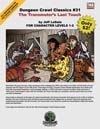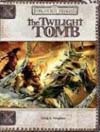

I’ve said before and I’ll say it again, published adventures are the lifeblood of D&D and other RPGs. Sourcebooks are great, many have become ‘must haves’ but the viability of any RPG in my opinion will always be the adventures because they help keep the game moving. They’re simply examples of how a game works. I haven’t seen anything other than sourcebooks for WOTC’s version of Star Wars and since 2002, I have yet to meet anyone running a campaign of it. Coincidence?
This is another review of two similar products with different designs and mindsets.
First up is The Transmuter’s Last Touch by Goodman Games, a publisher of D&D adventures that are blatantly plugged as dungeon crawls. Plot? Thin and intentionally written that way. Details? Some yet just enough for the DM to know where the monsters are and how much loot they have since the Players are supposed to wipe out everything. Artwork? Horrible. The maps? Mediocre and in the old blue-line style so they’re impossible to photocopy; I use the copies to mark the starting positions of the monsters and then adjust them as the Players move about. These criticisms don’t make TTLT exactly a horrible product, especially when the $2 pricetag is pretty appealing. The module still has a map and a premise to work with so it remains a DM time saver. My beef with Goodman Games is their philosophical tirade on the cover of all their modules.
“Remember the good old days, when adventures were underground, NPCs were there to be killed, and the finale of every dungeon was the dragon on the 20th level? Those days are back. Dungeon Crawl Classics adventures don’t waste your time with long-winded speeches, weird campaign settings, or NPCs who aren’t meant to be killed. Each adventure is 100% good, solid dungeon crawl, with the monsters you know, the traps you remember, and the secret doors you know are there somewhere.”
Being 38 and someone who got into D&D in 1981, I think Goodman Games is over-romanticizing the “good old days” of illogical dungeons composed of miles of 10-foot-wide underground tunnels ending with giant, thousand-square-foot chambers containing jumbojet-sized dragons. I know it’s just a game, but even dragons need food, air and a safe place to leave scat. Those were plausible adventures…when I was 13 and the plot holes of the last three crappy Star Wars films would’ve escaped my notice. Plus this bit about “all NPCs are meant to be killed” dovetails nicely into Star Wars again. Remember Darth Maul? Of course not. The character’s speaking parts [awesomely provided by Peter Serafinowicz] were cut from the film and he was just the final boss Obi-Wan cut in half. Quite a disappointing villain. Goodman Games espouses this design philosophy. D&D and its fellow RPGs have evolved, progressed and been refined (unlike the audience) over the last 30 years. I feel this evolution would’ve happened even if video games hadn’t made it to their current level of visual sophistication and chipped away at D&D’s market share. Sure, I have great memories of running my character throughWhite Plume Mountain and Castle Amber but my tastes and skills as a DM have improved too. When my players kicked in the front door of the Lizardfolks’ stronghold, the inhabitants executed an effective defensive strategy because they would. This made Danger at Dunwater more plausible and enjoyable for the players. I feel they appreciated having to deal with a real counterattack (despite their frustrations my friend Mark exclaimed a la Comic Book Guy, “Flanked…again!”) instead of me taking the “lazy” approach of letting them go from room to room, killing and looting everything along the way. Course it doesn’t mean you can’t tweak Goodman’s products to be more satisfactory which then destroys the time-saving element of it. I myself plan on using the bulk of TTLT in some kind of other adventure with a better written story in my campaign.
I apologize for the digression though. I couldn’t help giving a rebuttal to what I suspect is the publisher’s mission statement.
TTLT is a standard adventure for beginning heroes trying to find the lair of some kobolds (the Houston Texans or Chicago Cubs of D&D) who are oddly effective at raiding nearby villages. Obviously the kobolds are more dangerous than the players anticipate; they’re hiding out in some dead wizard’s old laboratory. I’m not giving anything way plot wise, the front cover already did. It’s a good launching point for a new set of first-level PCs with plenty of surprises to hit experienced players who think beating up a tribe of kobolds will be a walk in the park to attain second or third level.
Now on to the more satisfying published adventure, The Twilight Tomb from WOTC. Despite it being based as a mid-level scenario designed for four PCs set in the Forgotten Realms campaign, this can easily be moved to any fantasy setting with little effort for reasons I won’t spoil (my players do read this site and I would like to use it). The major monsters and enemies are laid out in the new albeit annoying DMG II format while the “generic” monsters just have references to the appropriate core rulebook. It may irritate some DMs that this adventure uses materials referenced in supplemental FR and other sourcebooks. These aren’t obstacles to really sweat. I already substitute a mind flayers’ psionic powers with sorcery so how hard is it to swap out shadow magic from FR with standard magic rules from PHB? Once the circumstances of how the heroes got involved with Tomb (no spoiler that it involves a tomb, it’s in the title), this adventure is also a dungeon crawl yet it’s well-written crawl containing several twists on the cliché I found more enjoyable and worthy of my money. I will concede Goodman’s point on NPCs and subplots for Tomb this once. Even the most diehard FR devotee knows who the villains are nor will they try to piece together the story about the tomb’s residents. I think they’ll be pre-occupied with their survival. The art work and maps are excellent, nothing more needs to be said there.
The Bottom Line: Obviously I liked Tomb much more than TTLT even though I spent five times a much on the former product ($9.95 v. $2). I would recommend purchasing both if it is within one’s budget but if you had to choose one over the other, then Tomb is the clear winner. Sure the price tag for TTLT is tempting but I’ve seen a score of better starting-level, random encounter adventures in Dungeon and from WOTC’s download area. TTLT is just bait to get DMs to buy another one of their other modules which cost $10 or more. There’s nothing sinister about that, I think it’s an effective marketing strategy and I applaud it. However, their dungeon crawls don’t push the D&D envelope into a new direction as Tomb does. WOTC’s critics may immediately blame the terms of the SRD. I strongly disagree. Goodman’s designs are restricted by their philosophy because Fiery Dragon and Necromancer have published equally memorable modules under the same licensing agreement. Again, TTLT if you need something quick to run for one night (or two with my slow pace) and you have two bucks to blow. Tomb may require a bit more preparation, work and money but it will be more satisfying for everyone involved.
